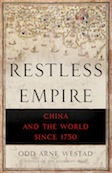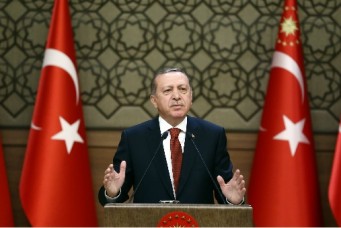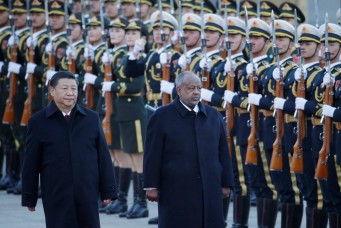Restless Empire
The meaning of Chinese history since 1750.
Restless Empire: China and the World Since 1750. By Odd Arne Westad. Basic Books, New York, 2012. 515 pp.
Xi Jinping’s rise, Bo Xilai’s fall, Chen Guangcheng’s escape, and maritime crises between China and Japan, Vietnam, and the Philippines—and ensuing protests in each nation—kept the foreign news bureaus in Beijing buzzing throughout 2012. The quick succession and at times relationship of these and other dramas with each other left even the most seasoned China-watchers scratching their heads and often reaching for the nearest Asia-Pacific map they could find. Leaders of the People’s Republic hoped it would be a quiet year, punctuated only by celebrations marking the once-a-decade gathering of the Communist Party’s National Congress, held in the capital city last November.
Despite the opaque processes by which their national leaders are chosen and government decisions are made, opinions among mainland Chinese in these first hundred days of Xi Jinping’s term were in abundant supply. Regarding the clout China has attained in global affairs alongside its tremendous economic growth at home, genuine feelings of confidence and positive expectations about the coming years predominate. But nearly just as often—and at times in the very same sentence—feelings of insecurity and mistrust of other nations are expressed as well. This is the paradox of Chinese nationalism. Norwegian historian Odd Arne Westad’s Restless Empire: China and the World Since 1750 provides a fine starting point for understanding the manifestation of this paradox today, be it in the PRC’s proud claims over uninhabited islands in the East China Sea or its defiant defense of the Syrian regime at the United Nations.
Westad calls his book a “revisionist take” on the foreign relations of China, in the sense that rather than writing a strict history on war and diplomacy, he aims to highlight “encounters” with the outside world, not only among high officials but also workers and businessmen, missionaries, students, and others. Thanks to this approach, we learn how migrations of mainlanders to distant parts of the Asian continent and across the globe have been critical to the introduction of foreign goods, technologies, and political philosophies to China for well over 200 years. Without this transmitting and domestic refashioning of ideas from overseas—most notably from Japan, Western Europe, Russia, and the United States—China’s historical trajectory would look unquestionably different. For Chinese revolutionaries of every generation Westad notes, “abroad has always been the initial staging ground for their dreams and hopes.”
A second, and equally important argument the author makes by way of illustrating these cross-cultural encounters is that it remains a challenge to this day to articulate just who and what have comprised China. Questions such as “Who counts as Chinese?” or “Where is China?” may appear academic, but try asking a native Beijinger or a Uighur in Xinjiang province or a Taiwanese Canadian, and you will get three different answers. Westad’s narration of clashes along China’s periphery since the Qing Dynasty makes clear the mixed success of rulers trying to promote “one inclusive identity” from afar. The persistence of a certain self-image in light of China’s imperial past—during which the country was central to the natural order of things in the known world and lacked perfectly defined borders—means matters such as where, geographically, China begins and ends, remain fiercely contested even among its own citizens. One need only note the nearly one hundred incidents of Tibetans self-immolating in the past year to recognize this fact. Or how taking a domestic flight or bus ride across Muslim-majority Xinjiang, seems, in a word, militarized in a way that riding the gaotie (bullet train) to Shanghai does not. China is not your typical nation-state.
Restless Empire provides a brisk overview of the most significant diplomatic and military episodes in modern Chinese history. It neatly summarizes the bloody catalog of forced land concessions and other humiliations at the hands of foreign powers, and the intellectual soul-searching and political movements emerging alongside them. Westad highlights points of contact between Chinese and non-Chinese at times and places where we might have hardly expected them. For instance, he tells of some 150,000 Chinese laborers recruited to serve on the Western Front in Europe in the First World War. By the time the war ended, these Chinese had aided the armies of France, Russia, Great Britain, and the U.S. in various ways; at least 3,000 lost their lives in the process.
Back on the mainland during roughly the same period, American missionaries and reform-minded educators were instrumental in establishing and managing Tsinghua University, Nanjing University, and the precursor to Beijing University—among the most elite academies in China today. For Westad, reminding readers of such cooperation with Western actors is not intended to be self-congratulatory. Rather, it is to drive home the point that China’s engagement with the world has run far and long before our own lifetimes—before the Nixon-Kissinger rapprochement or the 2008 Beijing Olympics or other conventional markers of its “opening up” or “coming out.”
If there is a single, overarching theme to China’s history as Westad sees it—whether governed by Qing emperors, early twentieth century republicans or Nationalists, Mao Zedong for a quarter century, or the market-oriented elites of today—it is the “encounter with capitalist modernity and of how Chinese shaped that modernity and were shaped by it” up to current times. He falls short of coming up with a firm definition or contemporary vision of this unique “Chinese modernity.” Linked to the topic is the thorny question of what governing model will prevail, or ought to, in China the years ahead, and Westad has his predictions; for instance, that Beijing might take a lesson or two about “good governance” from Singapore, Taiwan, Hong Kong, and Macao.
Competing ideas about the proper path of political and economic development for China are as central now in defining relations between rulers and ruled in the country as they have been in the past. The passions that differing views are capable of stirring were on full display to the world recently during the brief censorship scandal involving the outspoken Southern Weekly newspaper, based in Guangzhou. Borrowing a phrase coined by Xi Jinping himself a few days earlier, the paper planned to run a provocative new year’s editorial with the title, “China Dream: Dream of Constitutionalism.” When provincial officials blocked the article from going to press, journalists and other supporters staged a strike. Also appropriating Xi’s phrase, counter-protesters carried signs proclaiming, “We don’t want the American dream—We want the Chinese dream,” and called for the “traitor newspaper” to be shut down. Rather than brushing this off as empty rhetoric, we might consider it to be an expression of the quest for an elusive Chinese modernity that Westad argues has been at the heart of every revolutionary struggle in China’s history. Whether the dream can be converted into a stable reality for 1.3 billion citizens before the end of Xi’s term, and whether the road to it will be an entirely peaceful one, is far from clear.





